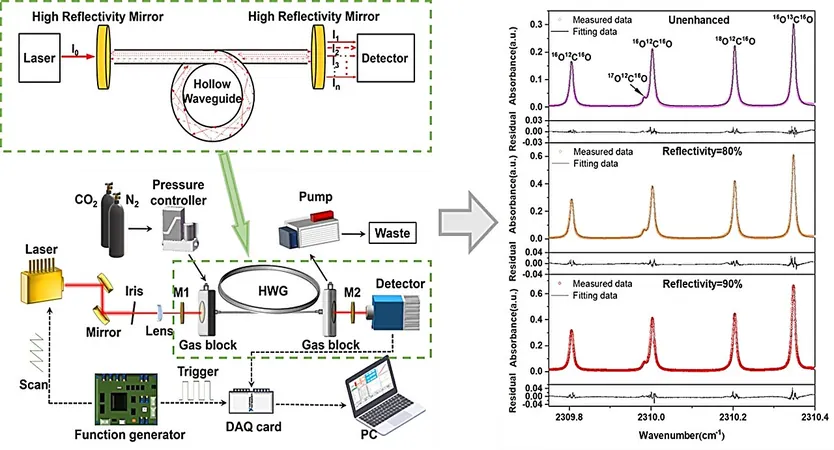
Revolutionary New Sensor Set to Change Breath Analysis in Medical Diagnostics!
2025-03-26
Author: Yu
Introduction
A groundbreaking development in breath analysis has emerged from a research team led by Professor Zhang Zhirong at the Hefei Institutes of Physical Science, part of the Chinese Academy of Sciences. They have unveiled an innovative sensor that significantly enhances the ability to detect multiple stable heavy isotopes in exhaled carbon dioxide (CO2) simultaneously and with remarkable sensitivity. This exciting discovery was detailed in a recent publication in the journal Analytical Chemistry.
The Importance of Breath Analysis
Breath analysis is gaining traction in the medical field as a convenient, non-invasive method for diagnosis. Among the numerous biomarkers found in breath, CO2 and its stable isotopes are particularly crucial. A prime example of its application is the 13C-urea breath test, a reliable method employed to diagnose Helicobacter pylori infections, a common cause of stomach ulcers.
Challenges in Traditional CO2 Detection
However, traditional methods of CO2 detection have faced challenges, primarily due to the limitations of hollow waveguides, which hinder the interaction between light and gas molecules, ultimately leading to reduced measurement sensitivity. The research team's novel approach introduces a mid-infrared enhanced hollow waveguide (EHWG) sensor that addresses these issues head-on.
Innovative Design of EHWG Sensor
"Our design is inspired by cutting-edge optical techniques," stated Professor Zhang. "By integrating high-reflectivity mirrors into the waveguide structure, we have improved the mechanism of gas detection."
Performance Validation and Clinical Relevance
This new EHWG sensor stands out not only for its increased precision in analyzing multiple isotopes in exhaled CO2 but also for successfully validating its performance with actual breath samples. The results were found to align closely with those of conventional hospital tests, pointing to its strong potential in clinical settings.
Portability and Future Applications
Moreover, the EHWG sensor is compact and lightweight, requiring only minimal sample volumes. This combination of portability and effectiveness positions it as an outstanding candidate for the next generation of breath diagnostic devices—from clinical diagnostics to on-the-spot testing in various healthcare environments.
Significance and Outlook
Professor Zhang emphasized the significance of their findings: "This research illustrates the great potential of the EHWG in the development of miniaturized, broad-spectrum, and lightweight gas sensors. We foresee it becoming the go-to choice for measuring small-volume sample gases."
Conclusion
As the medical community moves towards more efficient, non-invasive diagnostic tools, this cutting-edge sensor could redefine the landscape of breath analysis, leading to faster and more accurate diagnoses for patients worldwide. Stay tuned for further developments in this exciting field!


 Brasil (PT)
Brasil (PT)
 Canada (EN)
Canada (EN)
 Chile (ES)
Chile (ES)
 Česko (CS)
Česko (CS)
 대한민국 (KO)
대한민국 (KO)
 España (ES)
España (ES)
 France (FR)
France (FR)
 Hong Kong (EN)
Hong Kong (EN)
 Italia (IT)
Italia (IT)
 日本 (JA)
日本 (JA)
 Magyarország (HU)
Magyarország (HU)
 Norge (NO)
Norge (NO)
 Polska (PL)
Polska (PL)
 Schweiz (DE)
Schweiz (DE)
 Singapore (EN)
Singapore (EN)
 Sverige (SV)
Sverige (SV)
 Suomi (FI)
Suomi (FI)
 Türkiye (TR)
Türkiye (TR)
 الإمارات العربية المتحدة (AR)
الإمارات العربية المتحدة (AR)